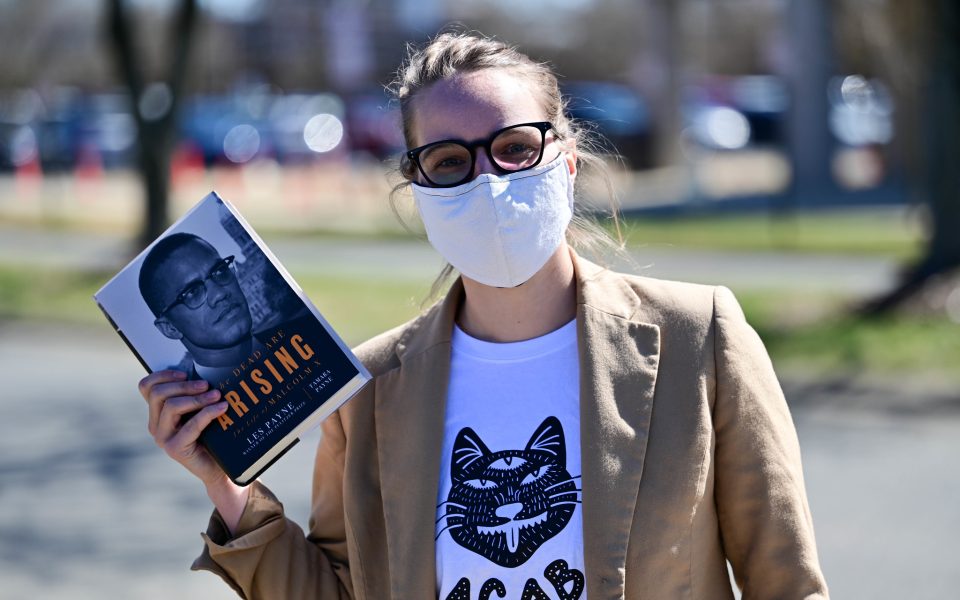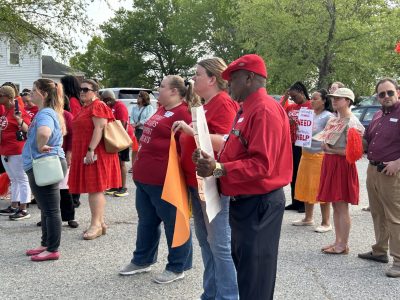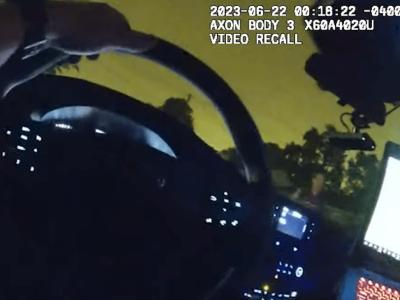Featured photo: Organizer Maggie Blunk outside the Alamance County courthouse today. (photo by Tony Crider)
Maggie Blunk organized a protest against COVID-19 conditions in the Alamance County jail in Graham that was disrupted when deputies made multiple arrests last September. Today, they were found guilty of disorderly conduct and resisting arrest.
Judge Lunsford Long, a visiting judge from Orange County who is handling dozens of cases stemming from arrests at protests in Graham last year, gave Blunk prayer for judgement, meaning that in exchange for giving up their right to appeal they will receive no penalties except for court fees.
Blunk, a Greensboro resident, organized the “99 Black Balloons” protest with Forward Motion Alamance to highlight a COVID outbreak in the jail that resulted in 99 infections. The protest began outside a county commissioners meeting that took place at 9 a.m. on a Tuesday and then moved down the street to the sheriff’s office, where the jail is located. Protesters had planned to read letters from incarcerated individuals.
Almost as soon as protesters set foot in the parking lot outside the jail, deputies started yelling for them to move to the sidewalk. One of the protesters, Nicholas Cassette, approached the entrance to the sheriff’s office separately from the other protesters. As the larger group of protesters retreated from the parking lot, deputies grabbed Cassette and threw him to the ground. Anger at the way Cassette was treated set off a cascade of additional arrests, as protesters denounced the deputies’ actions and moved back into the parking lot to check on their friend’s well-being. Nicholas Cassette faces charges of misdemeanor riot, second-degree trespassing and resisting an officer, but the prosecutor earlier dismissed a charge of disorderly conduct against his wife, Katie.
In early February, Judge Long found Dionne Liles guilty of second-degree trespass and resisting arrest for entering the parking lot and thrusting a sign up and down while chanting, “Let him go,” in response to Nicholas Cassette’s arrest. Liles was also charged with assaulting an officer, but Long found her not guilty on that count.
After helping their lawyer figure out how to access the courtroom wi-fi system to project video, Blunk took the stand wearing a shirt with a cat illustration and the letters “A-C-A-B,” an acronym for “all cops are bastards.”
Blunk told the court they work as a delivery driver and graphic designer.
“I made this shirt — $15 on Instagram through Maggie B. Designs,” she said, causing a titter of laugher to ripple through the courtroom. Judge Long gave no indication that he noticed or appreciated the messaging on the shirt.
“We had family members of people who were incarcerated who were going to speak,” Blunk testified, recounting the plans for the disrupted Sept. 8 protest. “We were going to read statements from incarcerated people. I do believe we were targeted for our speech. And it had a chilling effect on our ability to speak.”
Major Jackie Fortner, the major of operations for the Alamance County Sheriff’s Office, testified for the state that Blunk’s “foul language” drew his attention to her when he arrived on the scene in response to a call about a disturbance in front of the sheriff’s office. He testified that he was trying to assist the deputies in getting the protesters to go back to the sidewalk. Fortner testified that he heard Blunk say, “Fucking racist cops,” and “This fucking county is racist.”
By all accounts, incarcerated people were banging on the windows of the jail after protesters had chanted, “We see you, we love you,” while approaching the parking lot.
“My concern was a riot in the jail and a riot on the outside with the public,” Fortner testified. “The intensity of the voices was ramping up. Several other arrests had taken place. We were trying to have cover teams protect those other officers.”
The video played by the defense showed Blunk holding a megaphone and walking along a grassy strip next to the sidewalk while repeatedly saying, “People are going to die because of you.” Blunk was arrested in the grassy area.
Blunk testified that their speech was specifically directed towards Sheriff Terry Johnson, who was present at the protest, but more generally at the sheriff’s office.
As Fortner grabbed one of Blunk’s wrists to place her in handcuffs, they tried to hold onto the megaphone with their free hand. Reviewing the video, Blunk said they believes they said, “Free them,” and, “Put on a mask.”

The video backed up Blunk’s testimony and that of two other protesters who took the witness stand that they did not use profanity during the protest.
Called back to the stand, Fortner acknowledged that he didn’t hear Blunk use any profanity in the video, although he said he hadn’t paid close attention to it. Fortner also testified that he did not hear Blunk use profanity prior to the sequence of events that was capture in the video.
During Fortner’s testimony, Judge Long said it was apparent that Blunk was, at the very least, not using profanity at the time of their arrest.
Fortner emphasized fear on the part of deputies that the protest outside would result in unrest inside the jail.
“The inmates were beating on the windows very hard,” he testified. “It was rattling to the point that it felt like it was going to bust. It was the whole block.”
Under questioning from the judge, Fortner said the windows are bullet-proof, but he said he still felt they could crack, and there was a risk of inmates getting injured.
“Any spark could have caused something to be a tragic situation,” Fortner testified later in the trial. “We had to take control of the situation.”
But the two protesters who took the witness stand for the defense testified that there was nothing out of the ordinary about the people inside the jail banging on the windows.
Ann Humphreys and Katie Cassette testified that they participated in a vigil organized by Michael Graves, a former president of the Alamance County NAACP, with the sheriff’s office shortly after the death of George Floyd in May 2020.
“We shouted, ‘We see you, we love you,’” Humphreys testified. “They banged on the windows to indicate they heard us. No one was arrested.”
During their testimony, Blunk accused the sheriff’s office of lying about COVID protocols in the jail.
“I think they’re lying about everything, just like Major Fortner lied about me cussing,” they said.
When Assistant District Attorney Kevin Harrison tried to argue with Blunk’s statement that a deputy used the F-word when they were held in jail, Blunk responded by addressing the prosecutor by his first name.
“I’m just saying the truth, Kevin,” Blunk said. “It doesn’t matter if I’m guilty or not. You made us come to court and miss work. That’s the point, right?”
Even after the video evidence contradicted his claim that Blunk was using profanity, Fortner testified that he had to arrest Blunk because “she was cussing, using a magnified instrument [and] she would not get off the grass.”
Jamie Paulen, Blunk’s lawyer, said the fact that Blunk’s voice was amplified through a megaphone appears to have factored into the judge’s decision to find her guilty of disorderly conduct. Paulen also said that Long seemed persuaded that Blunk’s statements could have provoked a well-known neo-Confederate who was on the scene to retaliate, although that wasn’t an argument that the state made.
In another case heard today, Cierra Tate pleaded guilty to possession of a weapon at a parade, stemming from her arrest at an Oct. 31 march to the polls led by the Rev. Greg Drumwright. Tate was carrying a knife at the time of her arrest, but her lawyer told the judge his client was not using it in a combative manner. Under the deal, known as deferred prosecution, the district attorney agreed to dismiss the charge once Tate completes 48 hours of community service.
The district attorney also dismissed charges against Maurice Wells Jr. for resisting a public officer, injury to personal property and disorderly conduct stemming from his arrest during a Sept. 26 “We’re Still Here” march in Graham. The district attorney previously dismissed charges against two other protesters who were charged during the Sept. 26 protest. One of the protesters, Andrew Crabtree, was arrested after blocking the street at a crosswalk at the Historic Courthouse to ensure that protesters could cross safely. The other, Morgan Carter, was arrested when they tried to assist Crabtree.
The arrests took place near the end of the march, after dark, as officers dressed in military-style flecktarn and wielding batons surrounded the courthouse as a drone hovered overhead.
Three defendants, including Lee Vaughn, a photographer whose work has appeared in Triad City Beat, still face charges from the Sept. 26 protest.
Carey Kirk Griffin, one of the defendants, said many of the arrests occurred around the same time. She said she had stopped to get a beer at Beer Co. when she heard a commotion near the courthouse. She saw Wells getting arrested and also another antiracist protester named Shon Green getting assaulted by a counter-protester. Avery Harvey, who has pending charges for disorderly conduct and impeding traffic, was surrounded by about six deputies, Griffin said, and she ran across the street to assist him. Almost immediately, she said, she had four Graham police officers “aggressively pushing me up on the car.” Griffin faces a charge of resisting an officer from the Sept. 26 protest.
Vaughn recounted to Triad City Beat that he saw that Griffin was being detained, and went to help.
“I’m on the curb asking her: ‘What do we do?’” he recounted. “This guy fully suited in army gear runs up on me with an AR in hand. He says, ‘Back up!’ I said, ‘What do you mean? I’ve been shooting [photos] the whole time. I’m not getting in the way.”
As three or four officers surrounded him, Vaughn said he told them: “I’m not afraid of you. It’s wrong that you think you can approach me the way you did standing on the sidewalk that I helped pay for.”
Vaughn said the officers tackled him to the ground and slammed his camera down.
“It was excessive,” he said. “I wasn’t being aggressive. I didn’t approach anyone.”
Join the First Amendment Society, a membership that goes directly to funding TCB‘s newsroom.
We believe that reporting can save the world.
The TCB First Amendment Society recognizes the vital role of a free, unfettered press with a bundling of local experiences designed to build community, and unique engagements with our newsroom that will help you understand, and shape, local journalism’s critical role in uplifting the people in our cities.
All revenue goes directly into the newsroom as reporters’ salaries and freelance commissions.





Leave a Reply